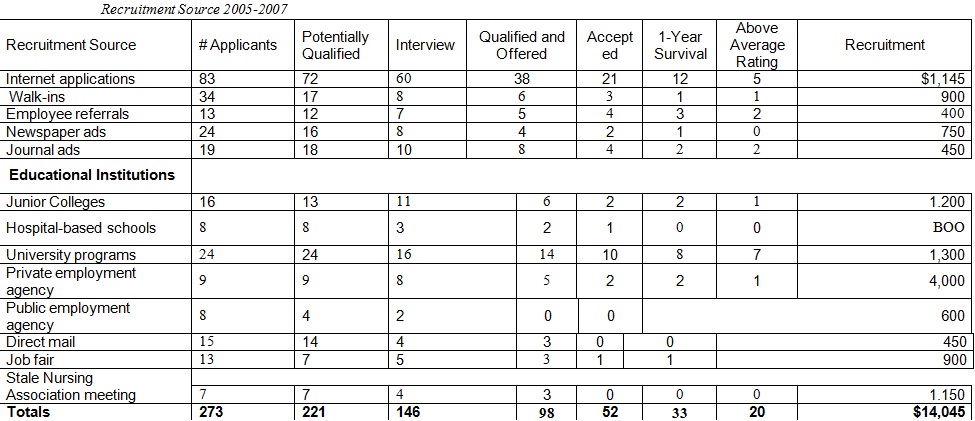Case 1 - Evaluating Recruitment Functions:
St. Vincent's Hospital is a 260-bed hospital in a north eastern city associated with the Roman Catholic Church. The administrator is Sister Claire, a 56-year-old member of the Daughters of Charity religious order.
During the last decade, the hospital operated with a nursing staff of approximately 450 registered nurses and skilled a nursing turnover rate of about 25 percent per year. The turnover rate was average for the city during this time period. However, it has accelerated to an average of 35 percent over the past three years.
These higher turnover rates have put additional pressure on recruiting process to offer larger numbers of qualified candidates. But, Sam Barnett, director of Human
Resources, has reported more difficulty locating qualified nurse candidates over the last three years. Barnett's office has prepared the recruitment data shown. The data show that 273 applicants (from all sources) had to be screened to produce 52 qualified candidates who accepted a job offer. One year later, 19 of these 52 had left the hospital. The last column shows direct and indirect costs of recruitment by source, comprising clerical time, supervisor lime, and direct costs, such as travel and postage. The human resource department has also conducted a telephone inspection of all the nurses they could locate who didn’t accept a job offer from the hospital during the most recent three-year period. Reasons for such rejections are shown in Exhibit.
Sister Mary Louise, the 62-year-old director of nursing service, has conducted all off-site recruitment for several years. This consists of both the nursing job fair and the State Nursing Association meeting. She has begun to feel burned out as a result of all her external recruiting and internal evaluation of candidates over years.
At a recent meeting, she recommended that an outside group (your group) be brought in to analyze the whole recruiting process, identify opportunities and problems, and suggest improvements. Sister Claire and Barnett readily agreed to an outside consultant because they are aware of current severe nursing shortages due to declining nursing school enrolments. St. Vincent's itself contributed to this enrolment decline by closing its own School of Nursing due to fewer applications and the high cost of operation.
Since recruitment of new nurses has begun to fall ere turnover of nurses employed at St. Vincent's, the vacancy rate has begun to increase. Five years ago, only 11 percent of staff nursing positions were unfilled. This percentage has now increased to 23 percent. One result has been an exhausting workload on the existing nursing staff. In addition to raised turnover, the symptoms of staff burnout (i.e., stress, conflict, absenteeism) are becoming more evident.


Reasons for Nurse Rejection of Job Offer from St. Vincent's Hospital, 1996-1999
Reason Number Percent
Recruitment Processes
Job attributes not communicated 2 4.3
Negative perception or recruiter 12 26.1
Negative perception of hospital 2 4.3
Lack of timely follow-up 13 28,3
Perceived lack of honesty in recruitment process 1 2,2
Negative Information from recruiter 1 2.2
Job Attributes/es
Location of hospital 3 6.5
Salary offer 2 4.3
Hours of work 2 4.3
Promotional opportunities o 0.0
Fringe benefits o 00
Working conditions 3 6.5
Perceived poor Job "match" 5 10.9
Totals 46 100.0
Answer the following questions:
Question1. How would you appraise the nurse recruiting strategy currently being used by hospital? Is the hospital using too few or too many recruiting sources? Why?
Question2. If you feel the hospital is using too many recruitment sources, which ones would you eliminate and why?
Question3. What stage or stages in recruitment process seem to be most amenable to improvements? What specific improvements would you advise to reduce the yield ratios? Why?